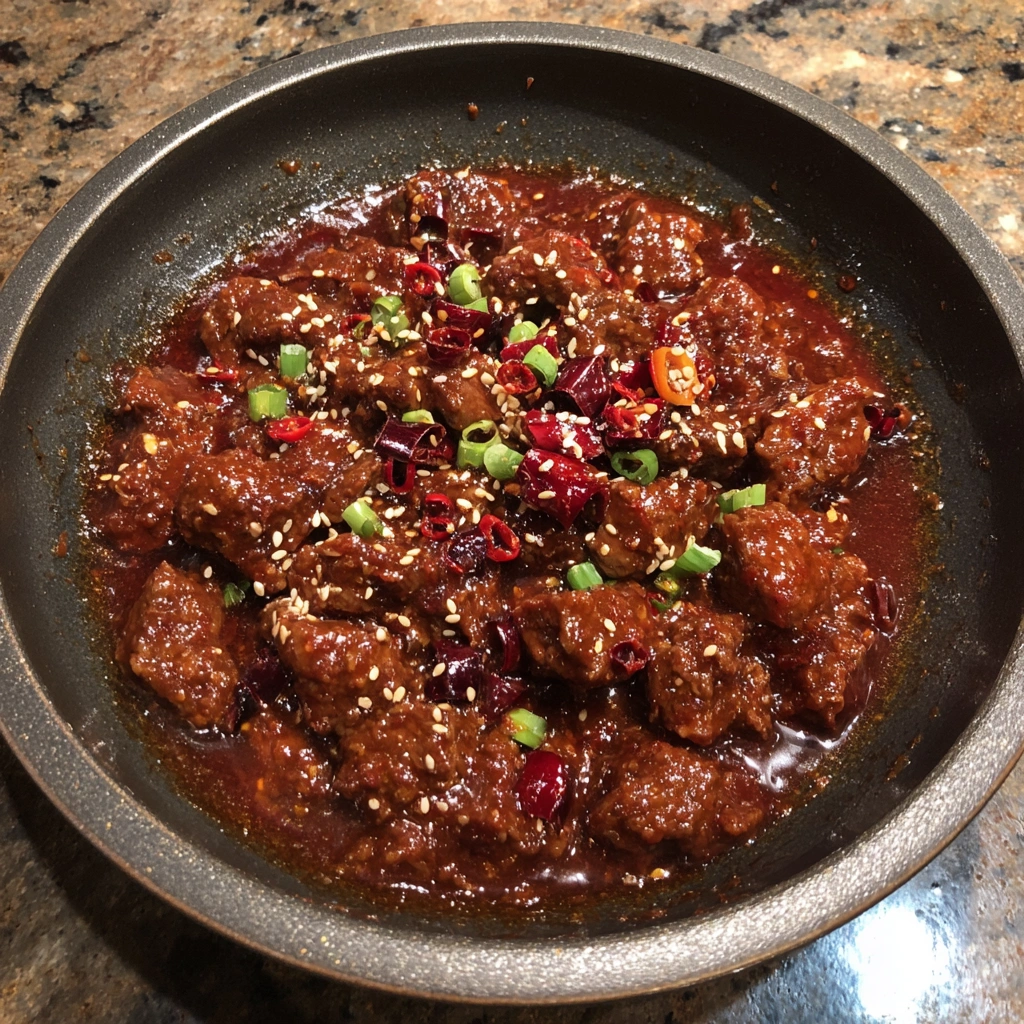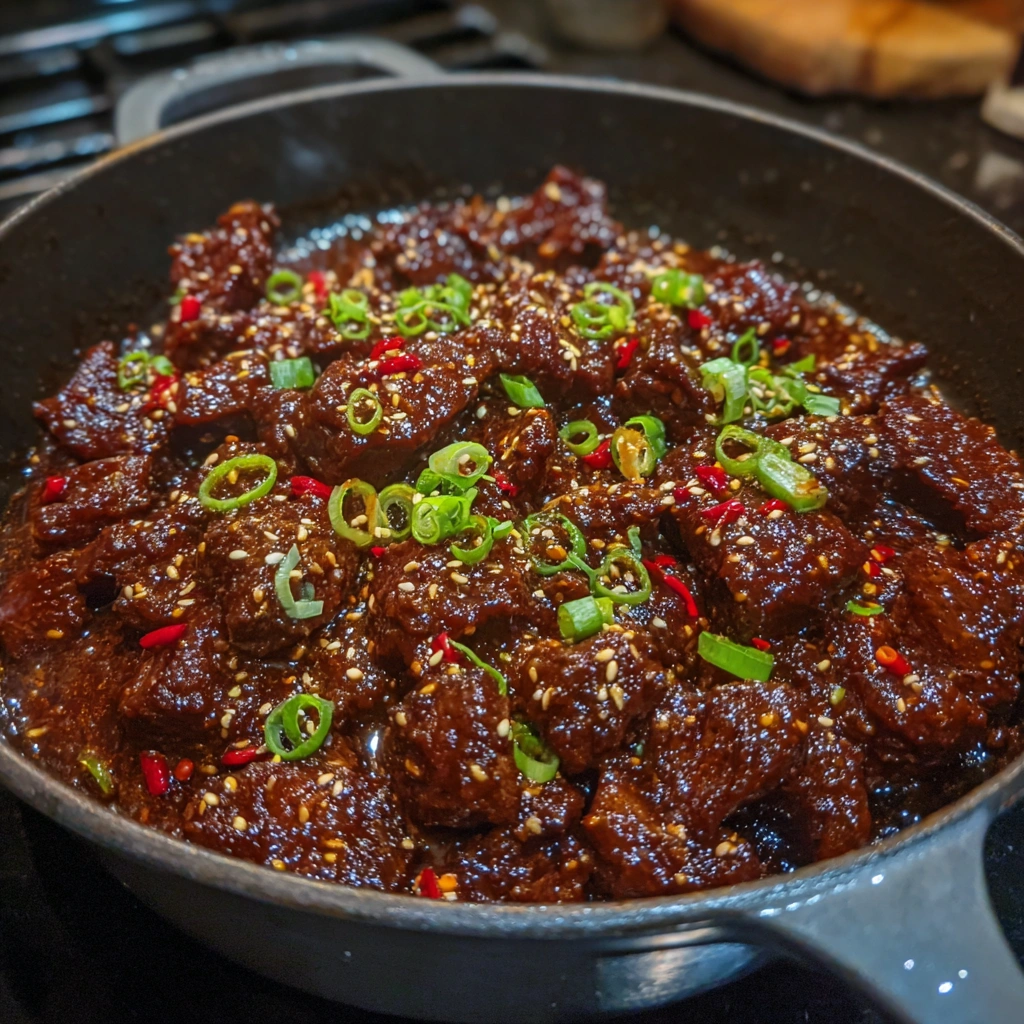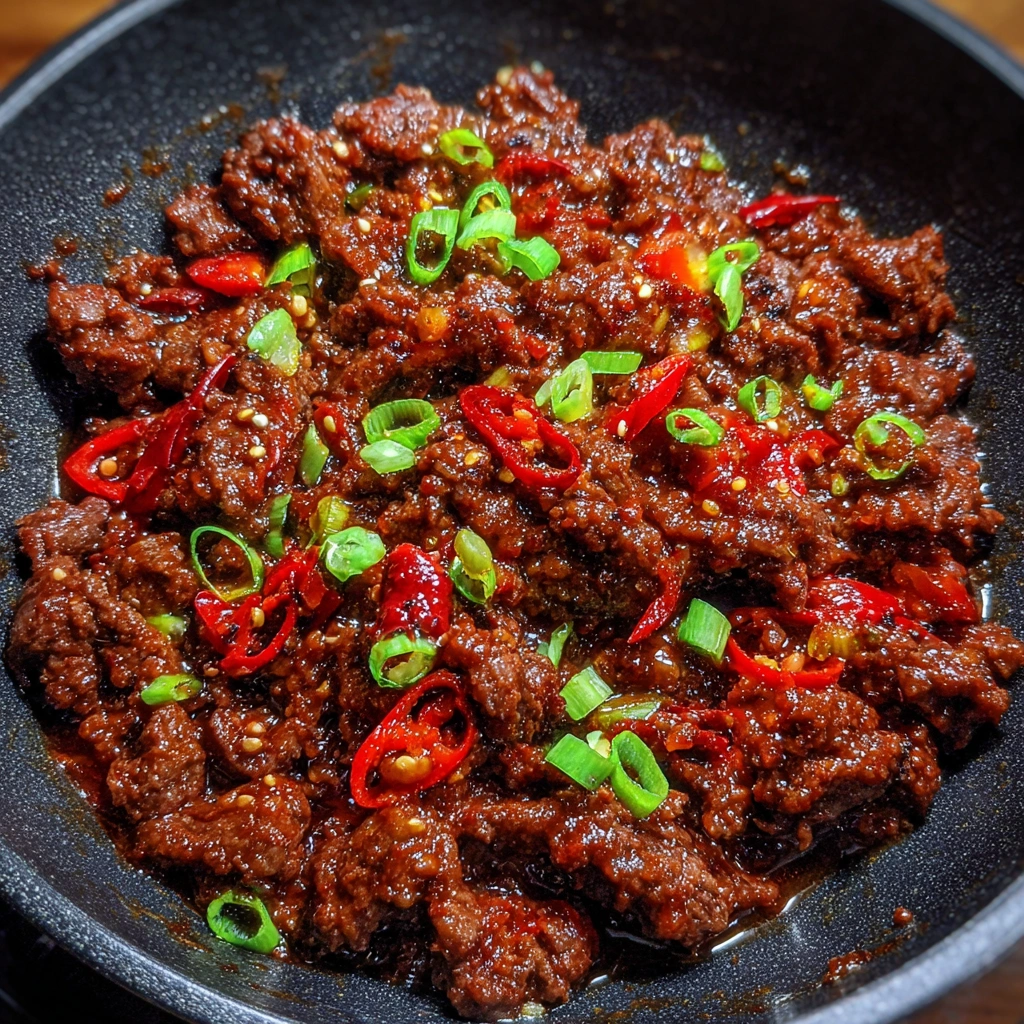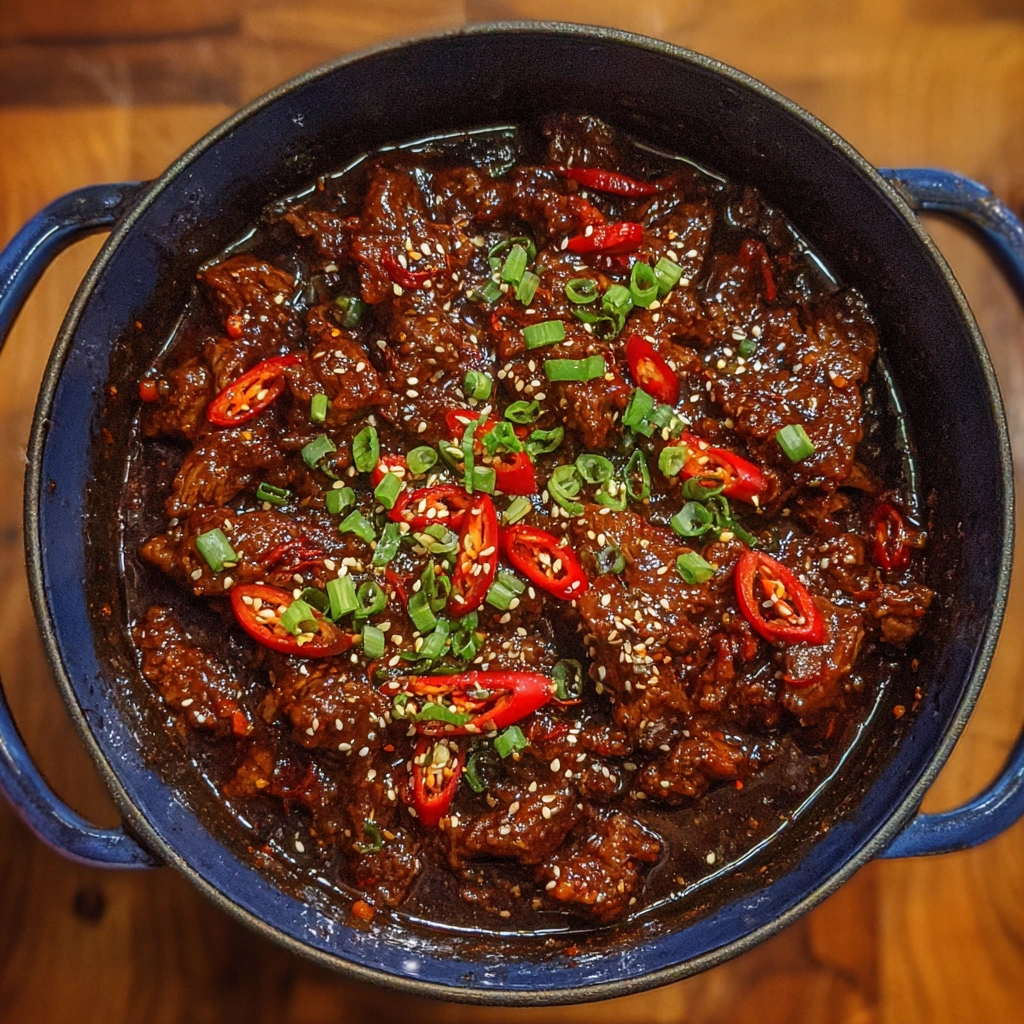Gochujang Chile Con Carne is my answer to weeknight dinner drama. It delivers big flavor without long braises or complex techniques.
I’m a professional chef who loves turning pantry standbys into bold, comforting meals. This recipe nods to my travels and the flavors that excite me most. Smoky heat from gochujang, browned beef for depth, and a glossy sauce cling to every spoonful.
For busy readers, moms and professionals alike, it’s a practical dish that nourishes a crowd. Leftovers taste even better. You’ll learn to balance heat and add a touch of sweetness at home.
Table of Contents
Table of Contents
What Make This Recipe It Special
Gochujang Chile Con Carne stands out because it marries Korean gochujang with classic chili, turning weeknight comfort into a smoky, multi-layered dish. I love how the paste brings both heat and a touch of sweetness, echoing the caramelized notes from browned beef. The result is a sauce with depth that clings to every bite, not a watery pot of chili. Leftovers taste even better tomorrow as flavors mellow and mingle. This isn’t just chili; it’s a quick, adventurous weeknight plan that still feels cozy and familiar. And yes, leftovers taste even better the next day. It makes busy weeknights feel effortless.
A warm, fusion-forward introduction
Think of it as chili with a passport. Gochujang brings smoky depth and a kiss of sweetness that complements beef, not masks it.
A practical weeknight solution for busy kitchens
It’s a one-pot meal that starts on the stove and finishes with a satisfying simmer. It freezes well, so you can stock the freezer for chaos days.
Quick notes on flavor balance and audience appeal
Keep heat approachable for all eaters; adjust gochujang and fresh chilies to taste, then finish with a splash of vinegar if needed.

Why You’ll Love This Recipe
Gochujang Chile Con Carne sizzles with bold, smoky flavor without long simmering. I reach for it on chaotic weeknights when time is tight but appetites are big. The gochujang paste builds depth and a gentle heat that pleases adults and kids alike. Every bite feels like a little victory for busy moms and professionals who crave comfort with speed. It’s reliable, budget-friendly, and forgiving. You’ll notice the kiss of sweetness and depth.
Ingredients
Here are the exact ingredients for Gochujang Chile Con Carne, lined up for a smooth weeknight cook. I’ve included substitutions and tips so you can tailor the dish to your pantry and preferences. Exact quantities are at the bottom of the article and printable.
- 1 tbsp sesame oil or olive oil
- 1 1/2 lb beef chuck or stew meat, cut into small cubes
- 1 medium onion, diced
- 4 cloves garlic, minced
- 1 tbsp grated ginger
- 2 tbsp gochujang (Korean chili paste)
- 1 tbsp tomato paste
- 2 fresh red chilies, sliced (adjust to spice level)
- 1 tbsp soy sauce or tamari
- 1 tsp rice vinegar or apple cider vinegar
- 2 cups beef broth
- Salt and black pepper to taste
- Optional toppings: chopped green onion, sesame seeds, or a drizzle of sesame oil
Core ingredients and their roles
- Beef chuck — sturdy protein that browns deeply for rich fond
- Sesame oil — aids browning and adds nutty aroma
- Onion — creates the sweet, savory base
- Garlic — brings aromatic punch and depth
- Ginger — adds warm brightness that lifts the heat
- Gochujang — the smoky, sweet heat that defines the dish
- Tomato paste — color, body, and a touch of acidity
- Fresh red chilies — deliver bright, direct heat
- Soy sauce or tamari — salty, savory umami binder
- Rice vinegar or apple cider vinegar — balance and lift
- Beef broth — creates a glossy, cohesive sauce
- Salt and black pepper — season to taste
- Optional toppings — finish with freshness and texture
Substitutions and optional add-ins
- Beef alternatives — use ground beef, pork shoulder, or lamb for a different bite; for a vegetarian version, swap in mushrooms or lentils with veggie broth
- Oil options — any neutral or nutty oil works; a little bacon fat adds depth
- Gochujang adjustments — for milder heat, reduce paste; to amp it up, add a touch more paste or a drizzle of honey
- Tomato paste swap — miso paste with a splash of water can deepen umami if you’re out of tomato paste
- Fresh chilies — deseed to tame heat or omit for a milder version
- Soy sauce alternatives — tamari or coconut aminos for gluten-free needs
- Vinegar options — lime juice can replace; omit if you prefer less acidity
- Broth substitutions — use vegetable broth for a lighter profile or water with bouillon
How to Make Gochujang Chile Con Carne
Step 1: Brown the beef (and tip)
Gochujang Chile Con Carne starts by browning beef in a hot pot. Pat the cubes dry, season, and sear until deep brown. Let each side form a crust that clings to flavor.
Don’t crowd the pan; it makes steam. Overscrowding steals color and the fond we want. Brown in batches if you need to.
Step 2: Sauté the onion
In the same pot, add onions and soften them. Cook until translucent and just hinting at sweetness.
Tip: a pinch of salt helps onions sweat. It speeds up the savory base.
Step 3: Aromatics, garlic, ginger, and chilies
Add minced garlic, grated ginger, and sliced chilies. Stir and cook until fragrant, 1–2 minutes.
Stir frequently to avoid sticking. This keeps the aromatics bright.
Step 4: Stir in gochujang and tomato paste
Stir in gochujang and tomato paste until coated and fragrant. The paste perfumes the pot and builds depth.
The gochujang brings smoky heat and a glossy color to the sauce.
Step 5: Return beef; add soy sauce, vinegar, and broth
Return browned beef to the pot. Add soy sauce, rice vinegar, and beef broth.
Stir to combine and scrape up all the fond from the bottom.
Step 6: Simmer low and slow
Bring to a gentle simmer, then reduce heat to low. Cover and cook until the beef is tender.
Plan about 1½ to 2 hours for a rich, cohesive sauce.
Step 7: Taste and adjust seasoning
Taste the chili and adjust salt, pepper, and acidity. A touch more vinegar can brighten the finish.
Remember, gochujang adds both heat and depth; tweak with care.
Step 8: Thickening and finishing touches
If you like a thicker sauce, uncover and simmer longer. Let the sauce reduce so it coats the spoon.
Stir in a splash of broth if it gets too thick or the beef dries out.
Step 9: Serve with toppings and suggested accompaniments
Serve this Gochujang Chile Con Carne hot in bowls. Top with chopped green onion, sesame seeds, or a drizzle of sesame oil.
Pair with rice, cornbread, or crusty bread for a complete cozy meal. It also freezes well for chaos days.

Step-specific tips
- Don’t boil vigorously; keep a gentle simmer to meld flavors evenly.
- Brown the beef in batches for deep fond.
- Taste heat gradually; add more gochujang if needed.
Tips for Success
Quick-tip bullets
- I brown the beef in batches for deep flavor.
- Let onions sweat; they add sweetness fast.
- Stir gochujang in after searing to keep aroma bright.
- Taste heat gradually; you control the spice.
Flavor harmony reminders
In Gochujang Chile Con Carne, balance heat, acidity, and salt for a cozy finish. I aim a glossy sauce with a touch of sweetness. If it tastes flat, splash in a touch more vinegar or sesame oil.
Equipment Needed
For Gochujang Chile Con Carne, these tools keep me organized and quick on weeknights—I reach for them every time.
Primary tools
- Heavy-bottomed pot
- Sharp chef’s knife
- Cutting board
- Wooden spoon
- Tongs
- Measuring spoons
- Ladle
Substitutes and alternatives
- No Dutch oven? Use a heavy pot with lid
- No ladle? Use a heatproof cup
- No tongs? Use two spatulas
- No measuring spoons? Use cups with measured spoons
Variations
Beef and protein swaps
- Beef options: keep chuck, or use ground beef for quicker browning and a different texture.
- Other proteins: pork shoulder cubes, lamb shoulder, or turkey thigh work well for variety.
- Vegetarian spin: mushrooms, lentils, or tofu with extra veggie broth for heartiness.
- For a beef-forward version of Gochujang Chile Con Carne, swap in ground beef or pork for speed.
- Half-and-half: mix ground beef with mushrooms for texture and umami without extra fat.
Heat level and sweetness adjustments
- To ease heat, reduce gochujang and skip the fresh chilies.
- To boost heat, add more gochujang or a touch of honey or maple syrup to balance.
- For balance, finish with a splash of rice vinegar to brighten the sauce.
Dietary-friendly variations
- Gluten-free: use tamari; check gochujang brands for gluten content.
- Low-sodium: use low-sodium broth and salt sparingly to control saltiness.
- Dairy-free: this recipe is naturally dairy-free; avoid sesame oil if needed.
- Vegan: swap in mushrooms or lentils with veggie broth; add a spoonful of miso for depth.
Serving Suggestions
Serving Gochujang Chile Con Carne is a cozy moment to share. These ideas keep weeknights easy.
Plate-and-presentation ideas
Garnish with green onion and sesame. I like to serve in rustic bowls for warmth and a welcoming look.
Pairings and finishing touches
I pair with rice, cornbread, or crusty bread. A squeeze of lime brightens the finish.
Gochujang Chile Con Carne: Elevating Flavor with Toppings and Sides
Gochujang Chile Con Carne shines even brighter when you finish it with thoughtful toppings and perfect sides. I love adding a few textures and bright notes to contrast the smoky depth. These ideas turn a cozy bowl into a restaurant-style moment at home.
Toppings that lift the dish
- Chopped green onion and a light dusting of sesame seeds
- A delicate drizzle of sesame oil for aroma
- Quick-pickled red onions or radish slices for zing
- Fresh cilantro and lime zest for brightness
- A dollop of sour cream or yogurt to cool the heat
- Crispy fried shallots or crushed tortilla chips for crunch
Sides and drinks to pair it with
- Steamed white or brown rice, or warm cornbread
- Crusty bread or soft tortillas to scoop
- A crisp cucumber salad or quick slaw to cut richness
- A cold lager or citrusy IPA, or sparkling lime water
- A bright agua fresca or iced tea to refresh the palate

FAQs
Can you use gochujang in chilli con carne?
Yes, you can use gochujang in chili con carne.
In Gochujang Chile Con Carne, it adds smoky depth and a gentle sweetness.
Stir it in with the aromatics after browning the beef.
How do you use gochujang chili paste?
Begin by stirring gochujang into the pot after browning the beef.
It coats the aromatics and builds smoky, sweet heat.
Tweak the amount to taste; start small and taste often.
Does gochujang go well with beef?
Absolutely.
The paste adds umami, depth, and a kiss of heat.
Browned beef meets the paste with a cozy, balanced finish.
What kind of chili is used in gochujang?
Gochujang uses red chili peppers as its base.
Different brands blend fermented soy, glutinous rice, and salt.
The peppers are usually gochugaru or similar Korean varieties.
Final Thoughts
Gochujang Chile Con Carne has become a weeknight hug in my kitchen. Its smoky depth and gentle heat keep everyone coming back for seconds. I love how leftovers taste even more layered, like a story that unfolds overnight.
Serving tips and toppings let me tailor it to picky eaters. I can heat it up for guests or dial it down for kids. With rice or bread, it becomes a comforting, no-fuss supper.
I tucked this into a busy week and watched it become a small ritual. It reminds me that flavor doesn’t have to be fancy to feel special. Cooking this dish is my little act of care for my family and myself.
PrintGochujang Chile Con Carne: 5 Bold, Smoky, Irresistible Tip.
- Total Time: 2 hours 15 minutes
- Yield: ~4–6 servings
- Diet: Diabetic
Description
Gochujang Chile Con Carne – a bold, smoky chili built around Korean gochujang paste for deep, savory heat.
Ingredients
- 1 tbsp sesame oil or olive oil
- 1½ lb beef chuck or stew meat, cut into small cubes
- 1 medium onion, diced
- 4 cloves garlic, minced
- 1 tbsp grated ginger
- 2 tbsp gochujang (Korean chili paste)
- 1 tbsp tomato paste
- 2 fresh red chilies, sliced (adjust to spice level)
- 1 tbsp soy sauce or tamari
- 1 tsp rice vinegar or apple cider vinegar
- 2 cups beef broth
- Salt and black pepper to taste
- Optional toppings: chopped green onion, sesame seeds, or a drizzle of sesame oil
Instructions
- In a heavy-bottomed pot or Dutch oven, heat sesame oil over medium-high heat.
- Add beef cubes in batches, searing until browned on all sides. Remove and set aside.
- In the same pot, add diced onion and sauté until soft, about 4 minutes.
- Stir in garlic, ginger, and sliced chilies. Cook for 1–2 minutes until fragrant.
- Add gochujang and tomato paste. Stir well to coat the aromatics.
- Return browned beef to the pot. Add soy sauce, vinegar, and beef broth.
- Bring to a simmer, then reduce heat to low. Cover and cook for 1½ to 2 hours, stirring occasionally, until beef is tender and sauce is thickened.
- Taste and adjust seasoning with salt and pepper.
- Serve hot, topped with green onion or sesame seeds if desired.
Notes
- For milder heat, remove some or all of the fresh chilies or use fewer slices.
- Brown the beef in batches to develop rich color and flavor.
- Gochujang adds both heat and depth; adjust with more or less paste to taste.
- Leftovers taste even better the next day as flavors meld.
- Prep Time: 15 minutes
- Cook Time: 2 hours
- Category: Main Course
- Method: Stovetop, slow-simmered
- Cuisine: Korean-inspired fusion
Nutrition
- Serving Size: 1 serving (about 1 cup)
- Calories: 360
- Sugar: 9 g
- Sodium: 520 mg
- Fat: 22 g
- Saturated Fat: 6 g
- Unsaturated Fat: 12 g
- Trans Fat: 0 g
- Carbohydrates: 14 g
- Fiber: 2 g
- Protein: 28 g
- Cholesterol: 95 mg
Keywords: Gochujang Chile Con Carne, gochujang chilli con carne, Korean gochujang chili, smoky chili con carne, chili with gochujang
